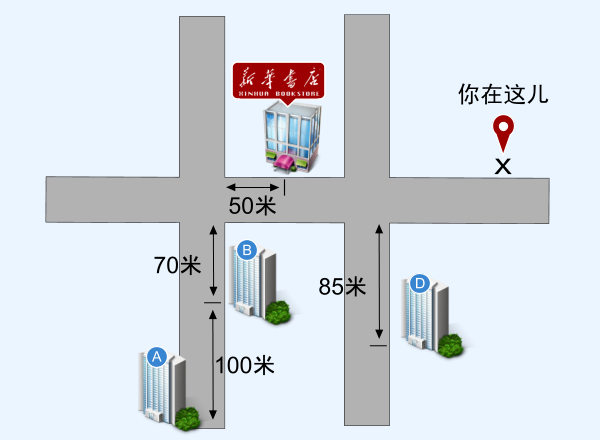Warning: file_put_contents(./cache/21_nopy.txt): failed to open stream: Permission denied in /data/clients/davidhoustin/chinese.gratis/www/method/index.php on line 275
Asking directions in Chinese - Lesson 21
In this online Mandarin Chinese lesson, we will learn how to ask for directions and understand the information received about the directions.


1. Vocabulary
Verbs
| Word | Pinyin | Translation | ||
| 1 | 换 | huàn | to change; to exchange | |
| 2 | 过 | guò | to cross (a passage) ; to pass | |
| 3 | 要 | yào | in this lesson: to need to; to have to | |
| 4 | 拐 | guǎi | to turn |
Other words
| Word | Pinyin | Translation | ||
| 1 | 离 | lí | at a distance of; away | |
| 2 | 多 | duō | in this lesson: (particle used to form interrogative sentences) | |
| 3 | 远 | yuǎn | far | |
| 4 | 近 | jìn | close; near | |
| 5 | 附近 | fùjìn | neighborhood; surroundings | |
| 6 | 那儿 | nàr | there | |
| 7 | 从 | cóng | (starting) from | |
| 8 | 到 | dào | up to; to go to; to arrive | |
| 9 | 大概 | dàgài | about; nearly | |
| 10 | 公里 | gōnglǐ | kilometer | |
| 11 | 米 | mǐ | meter | |
| 12 | 先 | xiān | first, firstly | |
| 13 | 然后 | ránhòu | then; afterwards | |
| 14 | 路 | lù | in this lesson: (classifier and suffix equivalent to "No" for bus lines) | |
| 15 | 马路 | mǎlù | street | |
| 16 | 十字路口 | shízìlùkǒu | crossroads (lit. "十 intersection character") | |
| 17 | 车站 | chēzhàn | bus stop | |
| 18 | 长 | cháng | length; long | |
| 19 | 堵车 | dǔchē | traffic jam | |
| 20 | 交通 | jiāotōng | transport network | |
| 21 | 的话 | dehuà | (placed at the end of a sentence to express a hypothesis) if; in the case where | |
| 22 | 小时 | xiǎoshí | hour (duration) | |
| 23 | 方便 | fāngbiàn | convenient | |
| 24 | 一直 | yīzhí | continuously; always | |
| 25 | 往 | wǎng | en direction de; vers in the direction of; to | |
| 26 | 天安门 | tiān'ānmén | Tian'anmen (historic and touristic site in Beijing) |

2. Grammar
A. Telling distance between two points
In Chinese, the preposition 离 ‹ lí › allowes for the indication between two points. It appears frequently in sentences, accompanied by adjectives like远 ‹ yuǎn › and 近 ‹ jìn ›.
- 天安门 离 这儿 很近 。 ‹ Tiān'ānmén lí zhèr hěn jìn. ›
Tian'anmen is very near from here. - 银行 离 书店 不远 。 ‹ Yínháng lí shūdiàn bù yuǎn. ›
The bank is not far from the library.
Instead of an adjective, some sentences follow the structure 有...米/公里 ‹ yǒu...mǐ/gōnglǐ› to indicate the exact distance.
- 天安门 离 这儿 有 三 公里。 ‹ Tiān'ānmén lí zhèr yǒu sān gōnglǐ. ›
Tian'anmen is three kilometers from here. - 地铁 离 学校 有 500 米。 ‹ Dìtiě lí xuéxiào yǒu 500 mǐ. ›
The subway is 500 meters from the school.
B. Expressing "(from) ... to (up) to ..."
从...到... ‹ cóng...dào... › is used in the same way as it is in English in a sentence like "(from) ... to (up) to ... ". If in this lesson, this structure is used for places, it can also be used for a period of time. Like for 离 ‹ lí ›, this structure can be followed by an adjective or a structure verb + object.
- 从 这儿 到 天安门 有 三 公里。 ‹ Cóng zhèr dào Tiān'ānmén yǒu sān gōnglǐ. ›
From here to Tian'anmen, there are three kilometers. - 从 地铁 到 学校 要 用 半个小时。 ‹ Cóng dìtiě dào xuéxiào yào yòng bàn gè xiǎoshí. ›
From the subway to the school, it takes half an hour. - 从 2004年 到 2008年,我 一直 在 北京。 ‹ Cóng 2004 nián dào 2008 nián, wǒ yīzhí zài Běijīng. ›
From 2004 to 2008, I was in Beijing all the time.
C. Expressing "first ... then ..."
The adverb 先 ‹ xiān › is often used with the adverb 然后 ‹ ránhòu › to indicate a series of two events in a same Chinese sentence.
- 你 先 往 左 拐,然后 往 前 走。 ‹ Nǐ xiān wǎng zuǒ guǎi, ránhòu wǎng qián zǒu. ›
First you turn left, then it is all straight. - 我 先 去 喝 咖啡,然后 回 学校。 ‹ Wǒ xiān qù hē kāfēi, ránhòu huí xuéxiào. ›
First I am going to drink a coffee, then I go back to school.
D. Questions with 多 ‹ duō ›
In Chinese the adverb 多 ‹ duō › is often used before an adjective to ask about the extent or the degree of something. For example, 多远 ‹ duō yuǎn › is used to ask about distance and 多长 ‹ duō cháng › about length.
- 从 这儿 到 天安门 有 多远 ? ‹ Cóng zhèr dào Tiān'ānmén yǒu duō yuǎn? ›
How far is Tian'anmen from here? - 坐 公共汽车 要 用 多长 时间 ? ‹ Zuò gōnggòngqìchē yào yòng duō cháng shíjiān? ›
By bus, how much time does it take?
E. Expressing condition with 的话 ‹ dehuà ›
的话 ‹ dehuà › is equivalent to "if" in English, except that it is placed at the end of the first part of the sentence in Chinese.
- 你 去 北京 的话, ... ‹ Nǐ qù Běijīng dehuà, ... ›
If you go to Beijing, ... - 不 堵车 的话,要 半个小时 去 天安门。 ‹ Bù dǔchē dehuà, yào bàn gè xiǎoshí qù Tiān'ānmén. ›
If there is no traffic jam, it takes half an hour to go to Tian'anmen.

3. Dialogues
Dialogue N° 1
- 天安门离这儿远不远? ‹ Tiān'ānmén lí zhèr yuǎn bù yuǎn? ›
- 不远, 很近。 ‹ Bù yuǎn, hěn jìn. ›
- 从这儿到天安门有多远? ‹ Cóng zhèr dào Tiān'ānmén yǒu duō yuǎn? ›
- 有6公里。 ‹ Yǒu 6 gōnglǐ. ›
- 从这儿到那儿怎么去? ‹ Cóng zhèr dào nàr zěnme qù? ›
- 去天安门要先坐690路,然后换37路公共汽车。 ‹ Qù Tiān'ānmén yào xiān zuò 690 lù, ránhòu huàn 37 lù gōnggòngqìchē. ›
- 坐公共汽车要用多长时间? ‹ Zuò gōnggòngqìchē yào yòng duō cháng shíjiān? ›
- 不堵车的话,大概半个小时。 ‹ Bù dǔchē dehuà, dàgài bàn gè xiǎoshí. ›
Translation :
- Is Tiananmen far from here?
- No, very close.
- What is the distance from here to Tian'anmen?
- There is 6 kilometers
- How to get there from here?
- To go to Tiananmen, one must first take the bus 690, then change for bus 37.
- By bus, how much time does it take?
- In the case there is no traffic jam, about half an hour.
Dialogue N° 2
- 请问,从这儿到咱们学校怎么去? ‹ Qǐngwèn, cóng zhèr dào zánmen xuéxiào zěnme qù? ›
- 这儿附近交通很方便。 你可以坐公共汽车或者地铁。 ‹ Zhèr fùjìn jiāotōng hěn fāngbiàn. Nǐ kěyǐ zuò gōnggòngqìchē huòzhě dìtiě. ›
- 我喜欢坐公共汽车。 ‹ Wǒ xǐhuan zuò gōnggòngqìchē. ›
- 118 路到咱们学校。 ‹ 118 lù dào zánmen xuéxiào. ›
- 118 路车站怎么走? ‹ 118 lù chēzhàn zěnme zǒu? ›
- 你从这儿一直往前走大概100米,到十字路口先往左拐, ‹ Nǐ cóng zhèr yīzhí wǎng qián zǒu dàgài 100 mǐ, dào shízìlùkǒu xiān wǎng zuǒ guǎi, ›
然后往前走大概30米 ; 你从那儿过马路。 ‹ ránhòu wǎng qián zǒu dàgài 30 mǐ; nǐ cóng nàr guò mǎlù. ›
- 谢谢! ‹ Xièxie! ›
- 别客气! ‹ Bié kèqì! ›
Translation :
- Please, how to get to our school from here?
- Transport system around here is very convenient. You can take the bus or the subway.
- I prefer to take the bus.
- The bus 118 goes to our school.
- How to go by walk to the 118 bus stop ?
- From here, you walk straight for about 100 meters, arriving at the crossroads, turn first to the left and then go straight for about thirty meters. From there you cross the road.
- Thank you!
- Welcome !

4. Exercise
Answer the following questions in Chinese, according to the illustration:

1. A楼离B楼远不远?
2. 从你在的地方到A楼怎么走?
3. 从A楼到书店怎么走?
4. 从书店到D楼怎么走?
5. 从D楼到B楼怎么走?
6. 从A楼到D楼怎么走?

Disease and hospital








